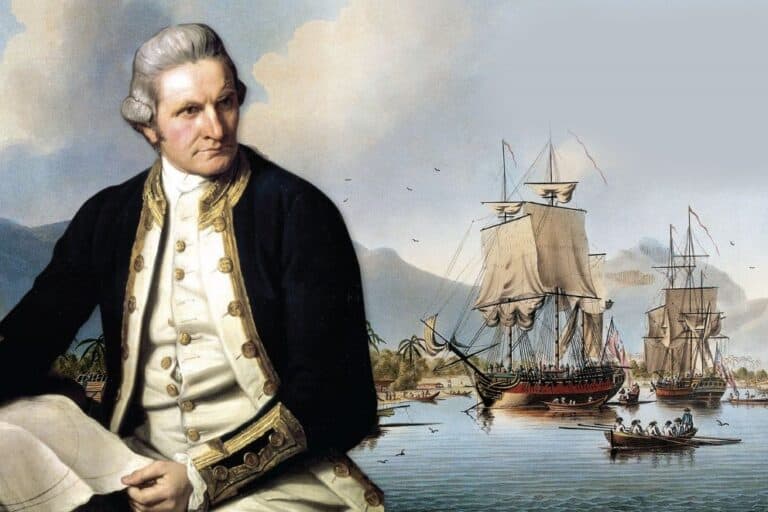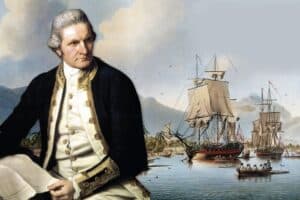It’s easy to become cynical about Valentine’s Day. Whether you’re tired of watching the same rom-com get remade for the dozenth time, you’re concerned about the 360,000 metric tons of carbon being dumped into the atmosphere to transport out-of-season flowers (via The Daily Orange), or you’re just tired of your mother asking you when you’re going to “settle down” – it can be a lot. But fear not, we have a story to lift your V-Day spirits and get you in the mood for love. The story of colonizer James Cook getting beaten to death by the indigenous people he was trying to steal land from.
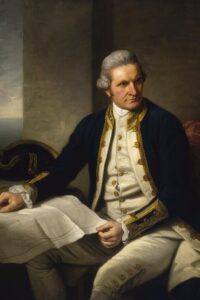
Who was Captain James Cook?
Captain James Cook was a gifted navigator and cartographer who rose from humble beginnings as a farmhand’s son and grocer’s apprentice to be celebrated by the scientific community of his time. Unfortunately for his legacy, his time was the 18th century and the place he and his contemporaries represented was Great Britain at the height of their genocidal colonialism.
After failing as a grocer’s apprentice, Cook apprenticed on ships, rising in the ranks as a seaman. From there, Cook enlisted in the Royal Navy where he served in the Seven Years’ War against France. After the war was long over, Cook commanded a ship on a scientific expedition meant to observe the transit of Venus. But, as is always the way with brutal colonial governments, there was a secret side mission.
Cook was given a second set of instructions for this voyage. Since he was already in the neighborhood, he was tasked with finding the theorized continent ‘Terra Australis’ and, of course, claim it for Britain. As far as history books are concerned, Cook did “discover” a “new” land. But in truth, people had already been living on this “new” land for 65,000 years, as an essay published by the National Library of Australia so aptly explains.
The aboriginal people Cook met in Australia and New Zealand lived an idyllic life of relative equality and abundance. Cook himself even wrote, “… they are far more happier than we Europeans.” Which he must have found offensive since he murdered plenty of them to claim their land for his country. To make it worse, he made no attempts at alliance or treaty. All so Britain could have a massive penal colony.
The effects of Cook’s voyage are still felt by indigenous people today in land loss, discrimination, legal barriers placed against them by local governments, and much, much more. Don’t worry though. He got his comeuppance.
Join the Obscurix Newsletter!
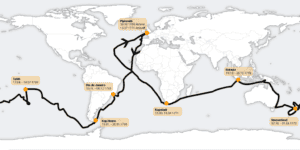
James Cook arrives in Hawaii
After he finished violently “claiming” land for his country in the southern hemisphere, the crown turned him on indigenous populations north of the equator. In 1776, he was sent on an expedition to find a northwest passage through North America.
In an astronomical set of coincidences, Cook landed in Hawaii by way of Kealakekua – a bay whose name literally translates to “The path of the god” – during a four-month-long ceremony for the regional god of agriculture, rain, fertility, and peace. Due to his accidentally perfect timing, the indigenous people on the island believed that Cook was an incarnation of this deity.
Cook spent a month in Hawaii receiving undeserved divine reverence before setting sail. Unfortunately, storms damaged his ship and forced him to turn back around. By this point, the celebration was over. The locals weren’t exactly expecting their deity to return so soon, and it caused Cook’s expedition some – well – issues. Let’s just say he returned to a much different vibe than he was expecting.
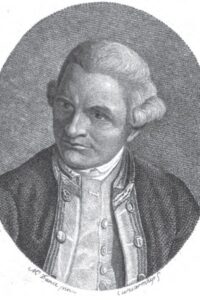
James Cook is killed on Valentine’s Day
On Cook’s second arrival, the local indigenous population met him with sheer hostility. It wasn’t until the Indigenous Hawaiians stole one of his boats that Cook decided to retaliate. This, it would turn out, wouldn’t be the British captain’s best idea.
Cook and nine marines attempted to take Kalei’opu’u, the sacred king of the Kānaka Maoli people, hostage so they could ransom the leader for their boat. The king initially agreed to go with Cook, but that changed when his people convinced him otherwise. In return, Cook tried to take the king by force.
The next thing he knew, an increasingly hostile crowd had surrounded Cook and his men. Cook’s fate was sealed when word of his men having killed a local chieftain on the other side of the bay reached the crowd. Captain James Cook, colonizing treasure of the English Crown, was stabbed in the shoulder, bludgeoned in the head, and knocked face-first into the shallows of the bay. Fate had finally turned the tides on Cook and his expedition. And, surely to the nearly colonized indigenous Hawaiians, it was a happy Valentine’s Day indeed.

